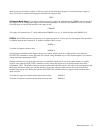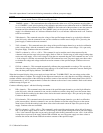
Local Operation86
Table 6-1. Bit Arrangement of the Status, Mask, and Fault Registers
Bit Position
76543210
Bit Weight
1286432168421
Condition
CP OC UNR OT OV -CC +CC CV
Note that bits can be set in an output’s fault register only when there is a change in either the status register or the mask
register. Therefore, if a bit is set in the mask register (unmasked) while the corresponding condition is true in the status
register, the associated bit will also be set in the fault register.
The UNMASK key is used to send a decimal number that is the sum of the weights of the bits to be set. The decimal
number 0 will clear all bits in the mask register so that status register bits cannot set any of the corresponding fault register
bits.
The following example uses the number 9 (8 + 1) to set the OV bit (8) and the CV bit (1) in the mask register of the
selected output.
UNMASK 9 ENTER
This example allows only an OV and/or CV condition to appear as faults; i.e., set the corresponding bits in the fault
register. Note that the mask register does not affect the status register; it simply determines which bits in the status register
can set bits in the fault register.
When you press the FAULT key, the contents of the fault register are displayed. For example, the display 9 indicates that
the OV and CV bits in the fault register are set. The fault register is cleared immediately after it is reset by pressing
FAULT.
Setting the Reprogramming Delay
A power supply’s output may switch modes momentarily after a new output value is programmed or the output is reset from
zero. To prevent these momentary conditions from appearing as faults, each output has a reprogramming delay parameter.
The delay parameter specifies a time period in which the CV, + CC, - CC, and UNR bits in the present status register are
masked from the fault register and from the overcurrent protection (OCP) circuit after certain commands are sent. Refer to
Reprogramming Delay, page 78, for additional details about the reprogramming delay parameter.
The delay time is initiated following a VSET, ISET, OVRST, OCRST, OUT on/off, or RCL command that is sent from the
front panel (or from a remote controller).
The delay time is settable from 0 to 32 seconds in .004 s (4 ms) intervals. The default (or power on value) is 20 ms.
For example, set the delay time of the selected output to 345 mS by pressing:
DLY .345ENTER
Local Control Of System Functions
The System Function keys consist of the ADDR, ERR, STO, and RCL keys as shown in Figure 6-1. These keys are
independent of the output selected and are used in setting the supply’s GP-IB address, displaying error messages, and
storing/recalling voltage and current settings for all of the supply’s output channels.
Setting the Supply’s GP-IB Address
As described on page 39 before you can operate the supply remotely, you must know its GP-IB address. You can find this
out locally from the front panel by pressing:
ADDR


















